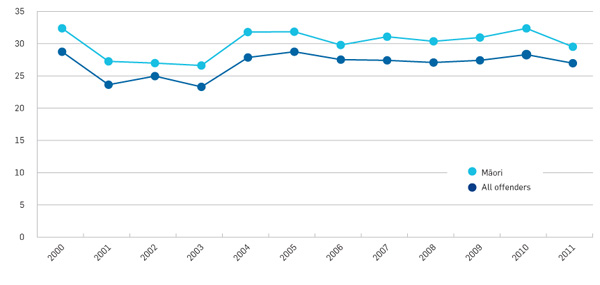Briefing for the Incoming Minister 2011
Executive Summary
The Department
The Department of Corrections is responsible for managing some of New Zealand’s most challenging citizens. We are currently managing 44,300 offenders. 8,600 are prisoners being held in our 19 prisons, (one of which is privately managed under contract) and 35,700 are managed in the community, serving a community-based sentence or order such as home detention or parole. Volumes of offenders managed by the Department increased significantly over the last decade. The prison population appears to have peaked and is expected to decline gradually over the next 10 years, while the number of people on community sentences and orders is also forecast to decline similarly over the next three years.
Snapshot of prisoners and community offenders
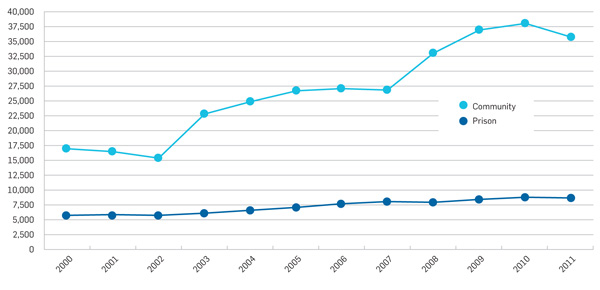
Our bottom line in working with offenders is to keep the public safe. Our ultimate goal is to reduce re-offending. Cutting the rates of re-offending leaves fewer victims and adds significantly to the social well-being of our communities.
Our aim is to reduce re-offending by 10 percent. We will achieve this by implementing Creating Lasting Change, the Department of Corrections’ key strategy to ensure offenders are managed securely, comply with the requirements of their sentences, and are helped to overcome the issues that contributed to their offending, so that they will leave our system as productive members of society.
Recent achievements
We have improved public safety.
- We have reduced prisoner escapes to an all-time low.
- We have sharply curbed the flow of contraband into prisons; fewer prisoners than ever are using drugs in prison.
Prison escapes per 100 prisoners
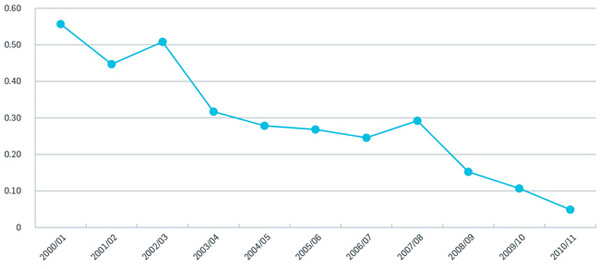
Positive general random drug tests
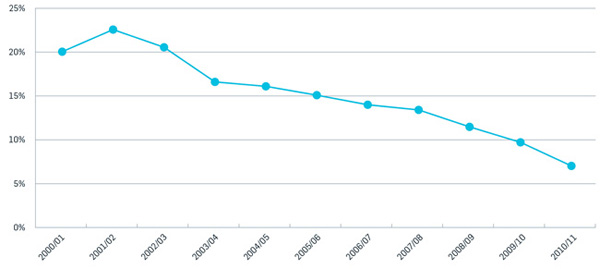
- We have improved the quality of offender management in the community: the rate of successful completions of community-based sentences and orders is at its highest level ever.
The Department has also reduced rates of re-offending.
- The rate of re-imprisonment for offenders released from prison has fallen.
- Reconviction rates for offenders serving community-based sentences or orders has also fallen.
Released prisoners: percentage re-imprisoned (12 month follow up)
Community offenders: percentage reconvicted (12 month follow up)
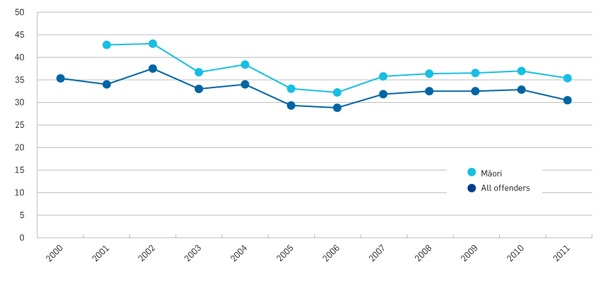
- More prisoners than ever are receiving support to overcome the issues that led to their offending, with positive impacts on re-offending.
- More prisoners have obtained literacy and numeracy skills, educational qualifications, and skills for future employment.
We have also achieved significant efficiency in our operating costs and have exercised leadership across the justice sector. The combined effect of these results is reflected in high levels of public confidence in the Department: in June 2011, 63 percent of New Zealanders thought the Department was doing a good job.
Opportunities and challenges
The Department has identified opportunities to further improve outcomes, alongside the ongoing challenges it faces. These are described under the Department’s four priorities:
- public safety
- reducing re-offending
- better public value
- leadership.
Public Safety
- improving physical and electronic security in prisons
- improving the health and well-being of prisoners, and further reducing incidents of self-harm
- more effective policies for improving compliance by offenders serving community-based sentences or orders
- effectively managing offenders who have committed violent crimes, including women
- effectively managing the increasing number of prisoners who are serving long sentences
- reducing gang membership among offenders.
Reducing Re-offending
- reducing re-offending by 10 percent
- ensuring most offenders leave prison with a job to go to
- extending the options for the delivery of drug and alcohol treatment and making programmes available to more prisoners
- investing more with young offenders, to prevent them continuing on to a lifetime of crime
- increasing the numbers of prisoners completing education
- increasing the numbers of prisoners gaining skills, recognised qualifications and work experience
- ensuring all prisoners are actively engaged in work, education and rehabilitation
- targeting rehabilitative opportunities for Maori offenders to improve their outcomes
- investing in reintegration services to help offenders resettle in the community.
Better Public Value
- ensuring all interventions are effective in reducing re-offending
- modernisingthe design of services and their delivery
- increasing flexibility through the use of technology
- ensuring the fiscal sustainability of the justice sector by improving efficiency and reducing costs
- identifying a long term strategy to optimise our prison configuration
- benchmarkingour performance against private sector contracted providers.
Leadership
- partnering with government agencies and others to take advantage of opportunities to improve our outcomes
- achieving significant reductions in offending by Maori through engagement with iwi/Maori leadership
- working as “One Team” across Corrections to achieve better outcomes
- prioritising the professional development and safety of our frontline staff.
Key dates in the next six months
Cabinet consideration
Some aspects have been withheld pursuant to section 9(2)(f)(ii) of the OIA to maintain constitutional conventions regarding collective and individual ministerial responsibility.
Legislation
Some aspects have been withheld pursuant to section 9(2)(f)(ii) of the OIA to maintain constitutional conventions regarding collective and individual ministerial responsibility.
- Corrections Amendment Bill – First reading and referral to the Select Committee
- Administration of Community Sentences and Orders Bill – First reading and referral to the Select Committee


